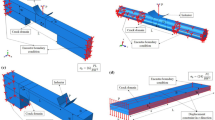Abstract
In conventional fracture-toughness testing, the line of application of the loads remains fixed with respect to specimen geometry. In this testing machine, the load moves with the advancing crack front, and displacement is used as the controlled variable to propagate and arrest a crack. The energy-release rate at the onset of crack propagation and, hence, the plane-strain fracture toughnessK Ic can be measured directly without compliance calibration or stress-intensity evaluation. The specimen is in the form of a flat plat 25 by 50 cm which is simple to machine and provides about 30 values ofK Ic. The versatility of the machine is demonstrated by making a statistical analysis ofK Ic for 7075-T6 Al by showing the effect of plate thickness on the fracture toughnessK c using a tapered specimen, and by evaluatingK c in 7075 Al as a function of aging temperature in a thermal-gradient-treated specimen.
Similar content being viewed by others
References
Weitzmann, R.H. andFinnie, I., “Measuring Fracture Toughness — A Simplified Approach Using Controlled Crack Propagation,”J. of Matls.,7,294–298 (1972).
Freed, C.N. andKrafft, J.M., “Effects of Side Grooving on Measurements of Plane Strain Fracture Toughness,”J. of Matls.,1,770–790 (1966).
Kirkwood, W.F. andPrado, M.E., “Three Dimensional Stress Distribution of a Double-Cantilever Beam with a Side Notch,”Cracks and Fracture, ASTM STP 601, 262–273 (1976).
Weitzmann, R.H. andFinnie, I., “Further Studies of Crack Propagation Using the Controlled Crack Propagation Approach,”ASTM STP 559, 111–126 (1974).
Irwin, G.R., “Fracture Mode Transition for a Crack Traversing a Plate,”Trans. ASME, J. of Basic Engrg.,82,417–425 (1960).
Kaufman, J.G., “Progress in Fracture Testing of Metallic Materials,” Review of Developments in Plane Strain Fracture Toughness Testing.ASTM STP 462,3–21 (1970).
Author information
Authors and Affiliations
Rights and permissions
About this article
Cite this article
Pujari, V.K., Finnie, I. & Hauser, F.E. A moving-load controlled-displacement fracture-toughness testing machine. Experimental Mechanics 21, 234–239 (1981). https://doi.org/10.1007/BF02326846
Received:
Accepted:
Issue Date:
DOI: https://doi.org/10.1007/BF02326846




